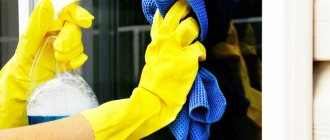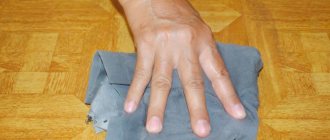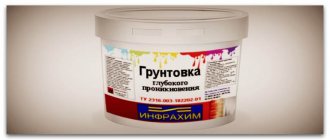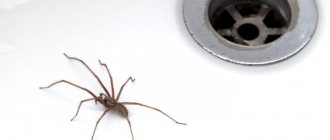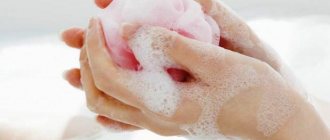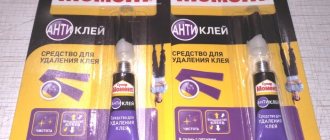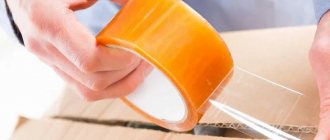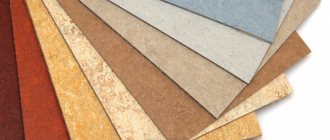Construction and repair work in a residential building is often accompanied by serious contamination of the glass surface. It is necessary to try to protect the windows from the ingress of a solution such as a primer. This is not always possible. Drops of the composition can still get on it, so you will have to take measures to clean the glass. There are several types of primer. Some are washed off with plain water, that is, without any effort. Others, on the contrary, are quite problematic to remove from the window. They are removed using special cleaning products sold in the store. Ordinary household cleaning compositions are also used. To answer the question of how to wash the primer, you need to understand what composition you are dealing with. This solution is a material that is used to improve the adhesion of the surface to paint or other decorative coating for wall decoration. When the primer dries, it undergoes a polymerization process and hardens. This leads to the fact that dissolving the composition becomes quite problematic.
What products and tools will help remove primer from glass?
You can clean the surface of window glass from a solution that improves the adhesion of the base to the decorative finish using the following available and special means:
- white spirit, acentone and other solvents;
- regular tap water;
- household detergents;
- strong chemical household products;
- baking soda, acetic acid and other traditional methods.
The tools you need to prepare are an abrasive sponge, scraper, sponge or blade. However, when choosing a specific product, you should take into account the type of primer that was used to stain the glass.
Choosing a method based on the type of soil
| Illustrations | Recommendations |
| Soil for wallpaper . The most harmless option. All you have to do is moisten the stain generously and wait until it becomes limp, then wash it off with a sponge. | |
| Acrylic primers. These compositions are also easy to soak with hot water, although it will take longer to soak. The exception is pigmented (colored) compounds; here the stain will have to be additionally wiped with white spirit. | |
| Adhesive primers. Almost all adhesive compounds come with deep penetration, and removing them is problematic. It's better to start with a scraper. If that doesn’t work, try moistening the stain with an organic solvent; it will soften the top layer and neutralize the adhesive properties. | |
| Phenolic soils . Mainly used for wood preparation. They can be removed from glass with xylene or solvent. Also try a mixture of white spirit and solvent in a 1:1 ratio. |
How to wash the primer used for wallpapering walls?
This composition is used to improve adhesion between wallpaper and the base of the walls. Such a solution, regardless of the manufacturer, is washed off quite easily. It is best to immediately remove fresh stains of this primer with a dry and then a damp cloth before it hardens. If this has not been done, you will have to tinker a little. At the polymerization stage, you will only have to use a damp sponge or washcloth.
When the primer solution hardens on the surface, you have to apply some effort. It is recommended to use various abrasive compounds for this purpose. First, moisten the contaminated area with the product and wait until the stain swells. Then, when the primer begins to soften, simply wipe off the composition with a clean rag or sponge. There is no need to use a scraper or blade. Then this place is washed with water, and that’s it, there will be no stains or streaks left.
How to prevent soil stains on walls and floors
Don’t think that painting is a simple matter. Often, even experienced builders stain linoleum or floor tiles, as well as window glass or window sills with primer. And if such stains are not washed off immediately, then over time they turn into a rather complex problem.
To avoid such difficulties after renovation in a country cottage or city apartment, you can try to protect the surfaces as much as possible from the risk of staining them with primer. How to do it?
Regular cellophane is a good way to protect against unnecessary stains
Just adhere to the following rules when performing all repair work inside a country cottage or city apartment:
- To prevent the solution from getting on various surfaces that do not need priming, you need to completely cover them with cellophane. Be sure to glue the joints with regular stationery tape;
- To protect yourself from allergic reactions and other health-related complications, be sure to carry out all work in protective clothing and a mask. Also ventilate the room regularly, because the soil has a pungent odor.
How to remove acrylic type primer from window glass?
This type of primer also does not cause any difficulty in removal. It can be easily removed from absolutely any smooth surface. Glass and tile are no exception. Any stains that form are removed immediately with a wet cloth, making sure that no streaks remain. No chemical reagents are required. This also applies to abrasives. Acrylic primer, which contains dyes, is difficult to remove. They cause some difficulties in removal. To get rid of the colored composition, it is recommended to use a solvent such as white spirit. Pre-treatment of the glass surface with hot water, but not warm, helps to quickly deal with stains.
How to clean a plastic window sill. How to clean a plastic window sill
How to easily and easily wash a plastic window sill from any stains: step-by-step instructions
Unfortunately, even the most careful handling of a plastic window sill does not guarantee the absence of streaks on it. It's quite easy to deal with regular powder. But what about more stubborn stains?
How to get rid of dirt from plastic window sills - step-by-step instructions
Step 1. First, the plastic frame must be cleaned of dust. To do this, dissolve liquid dishwashing detergent or washing powder in warm water. We wash the window sill with the resulting solution and wait until it dries.
Step 2. It is important to choose the right washcloth. So, if the window sill is shiny, you can only wipe it with a soft cloth! If the window sill is rough and grooved, dirt can be removed with a stiff brush or sponge.
Important! Under no circumstances should you use metal scrapers, iron brushes or other abrasive materials to clean the surface, as they can leave scratches and microcracks!
Step 3. As a last resort, dry dirt can be removed with a rubber sponge.
Step 4. If residues of glue, primer and other building materials have dried on the windowsill, they must first be soaked. To do this, pour hot water directly onto the contaminated area. Then after 10-15 minutes the dirt can be removed with a rubber sponge.
Step 5. Dirt often accumulates in the areas between the frame and the window sill. You can remove it with a toothbrush.
It is also not recommended to use acidic or caustic chemicals to clean plastic surfaces.
Common types of stains on plastic window sills:
- traces of tape, markers, felt-tip pens, etc.
- yellow from water;
- rooted fat (often found in cooking);
- hardened residues of glue, primer and other building materials resulting from repair work;
- signs of rust;
How to remove various stains using improvised means
One of the options for getting rid of the above contaminants is specialized chemicals. However, they are not always within reach or have the desired impact. In this case, it is better to resort to improvised means.
Yellow spots and rust marks
The simplest and at the same time effective way to get rid of rust and yellow spots is a soap solution.
How to remove deep penetration primer from glass?
A distinctive feature of this composition is that it contains phenols. It is used for processing wood. The polymerization process of such a composition depends on many factors, but on glass it occurs in less than one day. When fresh, like any other, it can be removed with a regular cloth. If the primer with phenol hardens, you will have to use solvents with a chemical composition. Among such products, white spirit, solvent or xylene are best. To achieve the greatest effectiveness, these compounds are mixed together in equal proportions.
The process of removing primers with phenols consists of the following steps:
- moistening the glass surface with warm water;
- applying a solvent to the stain;
- waiting a few minutes (5-10 is enough);
- wiping the glass with an abrasive material without pressing hard;
- repeating the above steps;
- wiping the glass with a clean soft sponge or rag.
It is not recommended to press or press on the glass. All movements should be soft. The steps can be repeated several times until the composition is completely removed.
What is a primer and what is it used for?
A primer or primer is a building material that is used to increase the adhesion of plaster and future finishing (paint, wallpaper, decorative plaster, etc.).
If you do not use this substance when performing repair work in your home, the walls may soon begin to crack and the wallpaper may fall off. This will not only reduce all a person’s efforts to nothing, but will also significantly affect the quality of life and comfort of the person living in this house. That's why construction experts strongly recommend treating walls with primer before finishing them.
Related article: Attaching a window sill to a plastic window
We also note that this material must have a quality certificate so that it demonstrates the highest possible efficiency.
Adhesive primer
It is one of the most problematic compounds to remove. The solution is intended to impregnate the surface in order to improve the degree of adhesion between the base and the material for further finishing. They are not soluble in water. The problem is that they polymerize very quickly, and, therefore, even immediate removal does not eliminate the possibility of stains. The composition quickly adheres to any surface, including glass.
The only effective means of removing adhesive primer from window glass is mechanical removal. It is recommended to use a blade here. It should be very thin. It needs to be held correctly. The angle of pressure and direction should be close to 45 degrees. When they pass it over the glass, they try to touch the stain with the sharp edge of the blade. When frozen traces of the primer are removed, it is recommended to repeat the procedure.
Alternative Methods
People who do not have a construction education, most often during repair work, resort to traditional cleaning methods. You can also wash away dirt using traditional methods. Let's look at the most popular and effective:
- Vinegar or essence can quickly scrub off the primer.
- You can dilute baking soda in water and remove the resulting slurry with a sponge.
- You can moisten the material with acetone or solvent and clean it in this way.
For all these methods there is a single condition: it is better to distribute the substances over the entire surface of the primer and leave for several minutes for contact to occur.
How can you make the cleaning process easier?
To ensure the removal is as efficient as possible and you don’t have to spend a long time on the glass with a blade that can scratch it, it is recommended to use organic solvents. They contain esters. These compounds neutralize the effect of the adhesive primer. Proper preparation of the stain before removing any remaining product with a blade allows you to achieve the desired result.
It is performed according to the following scheme:
- in organic solvents, moisten a piece of clean cloth and apply it to the stain;
- wait about half an hour and remove the rag from the surface of the glass.
Now that the primer has acquired a jelly-like shape, use the blade. In this case, it can be replaced with a spatula. Re-processing will no longer be required. To complete the cleaning, wipe the glass with a sponge soaked in a soapy solution and then wipe it with a damp, clean cloth.
Scraper, blade or abrosine sponge
It is easy to wipe off the primer with available tools; the main thing is that you need to act delicately so as not to damage the surface. Builders sometimes resort to tricks.
Moisten the cloth with water and place it on the place where there are primer stains and leave for several hours. After this, a blade or scraper will easily remove the dirt. Prolonged and careful rubbing with an abrosine sponge will also give a good effect.
Strong cleaning agents
The methods described above for removing primer from glass do not always work. The task can be complicated by the fact that the type of composition may be unknown, for example, the work was carried out by craftsmen, and after the team left, stains were discovered on the glass. In such a situation, it is recommended to use chemical household products that can remove problematic and persistent stains. The most popular products are Hodrupa, Veroclean, Corvette, Dopomat, Powerfix, Atlas Zsop.
The listed compositions have an alkaline base. The exception is acidic Powerfix. Due to this composition, it is used when cleaning ceramic tiles. They are applied to the stain and wait for some time. When the primer softens, rub or scrape the composition from the surface. The solutions are active chemicals, so you need to wear protective glasses and gloves when working with them.
Simple ways to remove dried primer
You can wash a deep penetration primer that has dried out in several ways - using a special product (solvent) or mechanical scrubbing. Each method is suitable for different types of primers and other materials. For this reason, especially in the case of solvents, read the instructions carefully to avoid scratches on glass or other surfaces due to the use of an inappropriate product.
Special solvents
Not all solvents are suitable for glass, wood (frames, doors), plastic. When purchasing them, consult a specialist or try the effect of the substance on a small area of the surface. A larger percentage of solvents are sold in the form of solutions or gels, their active ingredient being acids. Therefore, be careful when removing stains from clothes! They dissolve the top layer of primer and penetrate into it, facilitating subsequent removal. These products should not be used in the sun or at high temperatures - too high a temperature will reduce the effectiveness of the solvent.
Always strictly follow the instructions supplied with the specific substance. Some recommendations apply to all solvents:
- Apply the product with a brush or spatula (according to its consistency) onto the initial layer for 15 hours.
- After loosening the primer, remove it with a spatula.
- If the primer layer is thick or very dry, one application will not be enough. You will have to repeat the procedure, sometimes even several times.
- After finishing cleaning, wash the glass (or other surface).
- Remember you are using a chemical. When working with solvents, protect your hands with gloves and your eyes with safety glasses or a shield.
Folk remedies
It is not necessary to use store-bought chemical detergents. You can get by with ordinary improvised materials. Table vinegar, baking soda, and boiling water will help remove primer stains from glass. Boiling water is poured over the glass. Next, vinegar is applied to the stain. It is not pre-diluted. Wait about 15 minutes, go over the surface with a sponge. When these manipulations are completed, baking soda is poured on top, and then the area is wiped again with a damp cloth. If it was not possible to get rid of the stain the first time, the manipulations are repeated again. In some situations, this method turns out to be powerless, so you have to use the potent substances listed above.
What to do if none of the remedies helped?
If your window sill is not new for a long time, there are small scratches on it, and you still haven’t managed to cope with the yellowness, you will have to resort to more radical measures:
- One of the easiest and fastest ways to update a plastic window sill is to painting special enamel for PVC. The composition of the enamel ensures the resistance of the paint and varnish coating to mechanical stress, abrasion and cracking. The enamel will also fill scratches and level the surface;
- Another budget way is pasting surfaces PVC film. Its surface is very smooth, which will make it easier to clean in the future; the film can be selected in either a standard white color or a colored one that matches the overall interior. The disadvantage of this method is that the film is easy to scratch. Therefore, there is a possibility that you will have to re-glue it more than once;
- For those who don’t want to bother at all and try different cleaning methods, we advise you to contact special cleaning companies. They have a full arsenal of miracle products that allow you to both remove old dirt and polish a scratched surface.
How to prevent surface contamination during repairs
Knowing how to remove primer from windows, you can carry out the cleaning process efficiently. But this is always a labor-intensive process. It is much easier to prevent stains from appearing on glass. To do this, before starting finishing work, experts recommend covering the window opening and window sill with shrink film. It has minimal thickness. It will not block the penetration of daylight. Attached to the frame with masking tape.
Only thick polyethylene can be laid on the floor. Such simple precautions will help greatly simplify general cleaning after renovation and will not rack your brains about how to wash silicone sealant from glass, regular primer or acrylic paint.
What is the root of the problem
All such compositions are designed to increase the adhesive (cohesive) qualities of surfaces; no repair can be done without them now. It depends on the soil how firmly, for example, wallpaper, putty or paint will stick.
Related article: How to insulate metal-plastic windows for the winter
Any soil contains either water or a solvent as a diluent. The very quality of the coupling is ensured by special polymers.
So, as long as these polymers are diluted with liquid, removing a blot or splash will not be difficult. So, in the first 30 minutes after application, the composition can still be washed off with a wet sponge, and then the liquid evaporates and the polymer filler crystallizes.
Fresh stains are much easier to remove.
But this is not the end yet, in the first 2-3 days the pollution can be washed off using a homemade method, however, this will be more difficult to do. If you remember the stains after a couple of weeks, it will be extremely difficult to remove them without a trace; the chances of a successful outcome are estimated at approximately 30–40%.
Don’t despair, glass is durable, and most importantly, acid-resistant, and here you need to choose the right primer to wipe off the glass with.
Use of industrial products for cleaning primers
If, wondering how to remove primer from tiles, porcelain stoneware, glass and other surfaces, you do not trust folk remedies, then chemistry will always come to your aid.
Chemical preparations are produced using acids and alkalis, thanks to which not only windows, but even ceramic surfaces and linoleum will be scrubbed off.
So, you can wash linoleum, glass and other surfaces with the following detergents:
- Dopomat-forte is a preparation containing alkali. The cleaner is able to cope with old primer stains on any surface.
- Hodrupa A is a preparation based on alkaline components. With its help, the primer is excellent for scrubbing off various surfaces, especially metal ones.
- ATLAS SZOP is a product containing various acids. With its help, ceramic, chrome and glass surfaces are perfectly scrubbed. The product is contraindicated for floor coverings in the form of linoleum.
When using household chemicals, you must strictly follow the instructions noted in the instructions, otherwise there is a high risk of damaging the surface being treated. In addition, the presence of acid in household products can cause injury to the skin.
